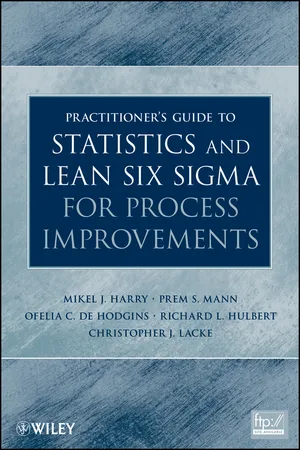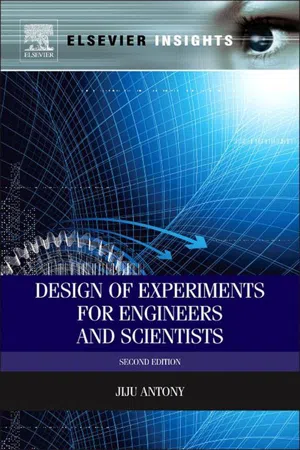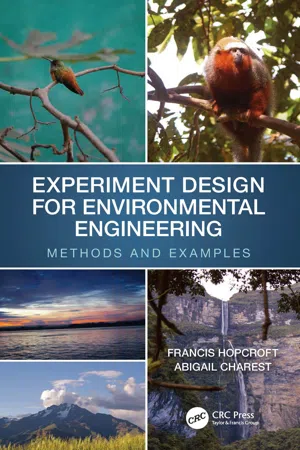Design of Engineering Experiments
The "Design of Engineering Experiments" involves planning and conducting experiments to optimize and improve products, processes, and systems in engineering. It focuses on selecting appropriate variables, designing experiments, and analyzing data to make informed decisions and improvements. This approach helps engineers understand and optimize the factors that influence the performance and quality of their designs.
5 Key excerpts on "Design of Engineering Experiments"
- Mikel J. Harry, Prem S. Mann, Ofelia C. De Hodgins, Richard L. Hulbert, Christopher J. Lacke(Authors)
- 2011(Publication Date)
- Wiley(Publisher)
...Many aspects of successfully designing and optimizing a process require efficient, accurate experiments: 1. Scientific method —all scientific information is based on experimentation. 2. Optimization of process parameters —process parameters of a transaction or service are the different elements of the service or elements of the transaction. 3. Cost savings— result from fewer experiments, increased investigator efficiency, and improved output from an optimal process are usually substantial. 4. Statistical methods —designing experiments to simultaneously gather information on all factors, offers additional savings compared to single-factor experiments. Figure 22.2 shows the general model of a process system and the different types of experimental factors. Figure 22.2 Graphically representation of two types of experimental factors (noise and controllable). 22.5 EXPERIMENT DESIGN TOOLS Most organizations collect data to monitor the “health” of their processes; however, frequently, there no corrective actions because the data do not contain meaningful information. When these organizations decide to perform an experiment in an effort to produce meaningful data on a specific CT (critical-to) characteristic, they design a one-factor-at-a-time test, and progress is slow and expensive. Organizations that use design of experiments (DOE) leverage their efforts by conducting well-thought-out experiments where several factors are altered simultaneously in one efficient series of tests. DOE provide more information in a shorter period of time than obtained from multiple single-factor experiments. The role of a statistically designed experiment is to identify the most influential factors or “vital few” associated with a particular CT characteristic and to define their relationships using analytical quantities. Since interactions between various factors are addressed, a single DOE can guide the experimenters to quickly improve their process...
- Jiju Antony(Author)
- 2014(Publication Date)
- Elsevier(Publisher)
...Kumar S, Tobin M. Design of experiments is the best way to optimise a process at minimal cost. IEEE/CHMT 1990;:166–173. 7. Launsby R, Weese D. Straight Talk on Designing Experiments Colorado Springs, CO: Launsby Consulting; 1995. 8. Marilyn H. A holistic approach to the design of experiments. ASQC Stat Div Newsletter. 1993;13(3):16–20. 9. Minitab, February 2000. Statistical Software User Manual, Release 13 for Windows. 10. Montgomery DC. Design and Analysis of Experiments New Jersey, USA: John Wiley & Sons; 2001. 11. Peace GS. Taguchi Methods: A Hands-on Approach. New York, NY: Addison-Wesley Publishing; 1993. 12. Romeu, J.L., 2006. Teaching Engineering Statistics to Practicing Engineers, ICOTS-7, Salvador, Brazil. 13. Tanco M, et al. Is design of experiments really used? A survey of basque industries. J Eng Des. 2008;19(5):447–460. 14. Tanco M, et al. Barriers faced by engineers when applying design of experiments. TQM J. 2009;21(6):565–575....
- eBook - ePub
Experiment Design for Environmental Engineering
Methods and Examples
- Francis J. Hopcroft, Abigail Charest(Authors)
- 2022(Publication Date)
- CRC Press(Publisher)
...2 How to Design an Engineering Experiment DOI: 10.1201/9781003184249-2 The fundamental design of an experiment contains several distinct design elements. Those include the question to be answered; the variables involved; how the variables will be adjusted; the potential interferences that can occur; how the investigator intends to minimize or avoid the effects of those interferences, or to account for them in the experimental data; and what theoretical outcomes are expected. Once the data are generated, how those data are interpreted and how the results are presented will go a long way to validating the outcomes. Note that not all experiments succeed. If they did, there would be no need to do an experiment because the outcome could be accurately predicted. It is important, therefore, to recognize that failure is an acceptable component of investigation. That recognition will minimize the tendency to interpret data in a way that supports the expected outcome and to reject data that do not support that outcome. If the data are not what is expected, it should be assumed that the data are correct and that the theory is wrong or that there was an error in the experiment design or conduct. The investigator then needs to try to figure out why the theory or the experiment was wrong and how to redo the experiment to account for the new thinking. Certainly, equipment will occasionally fail, people will do things in a manner inconsistent with the planned protocol of the experiment, reagents will become contaminated, and all sorts of other things will go wrong with experiments. The data that are generated are always correct for the experiment that was done. If those data do not reflect the expected outcome, either the theory is wrong or the experiment incorporated some unknown flaw...
- eBook - ePub
- Patrick O'Connor, Andre Kleyner(Authors)
- 2011(Publication Date)
- Wiley(Publisher)
...That is not to say that such an interaction would always be dismissed, only that we can legitimately use our engineering knowledge to help interpret the results of a statistical experiment. The right balance must always be struck between the statistical and engineering interpretations. If a result appears highly significant, such as the temperature main effect, then it is conversely highly unlikely that it is a perverse result. If the engineering interpretation clashes with the statistical result and the decision to be made based on the result is important, then it is wise to repeat the experiment, varying the plan to emphasize the effects in question. In the hydraulic seal experiment, for example, we might perform another experiment, using type 3 seals only, but at three values of pressure as well as three values of temperature, and making four replications of each test instead of only two. 11.5 The Taguchi Method Genichi Taguchi (1986), developed a framework for statistical design of experiments adapted to the particular requirements of engineering design. Taguchi suggested that the design process consists of three phases: system design, parameter design and tolerance design. In the system design phase the basic concept is decided, using theoretical knowledge and experience to calculate the basic parameter values to provide the performance required. Parameter design involves refining the values so that the performance is optimized in relation to factors and variation which are not under the effective control of the designer, so that the design is ‘robust’ in relation to these. Tolerance design is the final stage, in which the effects of random variation of manufacturing processes and environments are evaluated, to determine whether the design of the product and the production processes can be further optimized, particularly in relation to cost of the product and the production processes...
- eBook - ePub
- E. Bright Wilson(Author)
- 2012(Publication Date)
- Dover Publications(Publisher)
...CHAPTER 4 THE DESIGN OF EXPERIMENTS In this chapter some general principles concerning the advance planning of experiments will be discussed. These will not concern the design of apparatus or the actual conduct of experiments, since these topics will be treated in Chaps. 5 and 6. Great progress has been made in recent years in experimental design; yet there remain many fields of science in which these new ideas can be further applied. 4.1. Some First Principles Before planning actual experiments, the investigator should obviously have a good basic understanding of the nature of the problem and of any relevant theory associated with it. Even a very imperfect theory will often provide existence theorems, limiting values, etc., of considerable utility in guiding experiments. Furthermore, it is almost essential that an experiment be designed on the basis of one or more preliminary hypotheses. These can be constructed more intelligently if a full knowledge of the theory and background of the situation is available. The experimenter will next be wise if he analyzes his problem and is thereby enabled to cast it into the simplest form. It is possible to break most problems into parts which are much more easily answered separately than together. Furthermore, it is almost always desirable or even necessary to approach the answers in stages, starting with the most idealized and simplified version possible. When this has been unraveled, more general cases can be attacked. For example, in studying the problem of detonation in explosives, it would have been hopeless to start with a high-explosive shell, whose shape, composition, and mode of initiation are too complicated to permit the basic principle to be discovered. Instead, essentially one-dimensional detonations in pipes were studied. The length was made great enough so that the conditions of initiation were unimportant, and the simplest possible chemical mixtures, particularly gases, were used...




